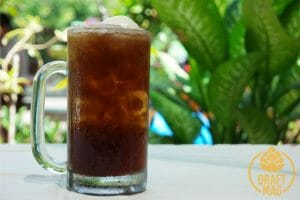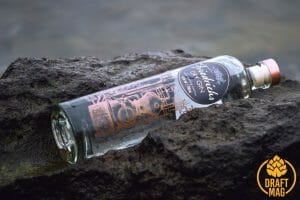How To Make Root Beer: A Step-by-Step Guide To Brew One
 How to make root beer at home is a question that baffles many beer enthusiasts. You can regulate the amount of sugar in the drink and play around with different flavors until you discover one that matches your taste buds. Homemade root beer has an old-fashioned charm with its strange barks and roots, leaves, blossoms, and berries.
How to make root beer at home is a question that baffles many beer enthusiasts. You can regulate the amount of sugar in the drink and play around with different flavors until you discover one that matches your taste buds. Homemade root beer has an old-fashioned charm with its strange barks and roots, leaves, blossoms, and berries.
Fortunately, brewing this old fashioned root beer recipe is quite simple. In this article, we’ll discuss everything about brewing root beer.
How To Make Root Beer
You can make root beers in three different ways:
-
Technique 1: Yeast with Various Spices
– Prepare the Yeast Ahead of Time
Heat one-half cup of the water in a small saucepan until it boils. Remove from the fire and set aside to cool to roughly 80 degrees. Stir in the yeast and let it bloom for a few minutes. It’s best if the water is at room temperature.
It is never a good idea to combine yeast with boiling water. Since the heat will destroy the yeast, you can’t utilize it to ferment your drink.
– Combine the Herbs and Spices in a Pot and Bring to a Boil
The next step involves making herbal tea that will serve as the foundation for your root beer.
- Fill a 5-gallon stainless pot halfway with distilled water.
- Combine cinnamon, licorice root, star anise, vanilla beans, cloves, orange zest, nutmeg, wintergreen leaves, allspice, and water in a large stockpot.
- Let it boil on high heat, then decrease to low heat and cook for another 30 minutes.
Turn the heat off when the water and herbs combination reaches a rolling boil. Allow two hours for the herbs to soak in the pot. Steeping the herbs absorbs all of their characteristics, ensuring that your drink is full of herby tastes and spiciness.
– Strain the Herbal Tea
You will need to separate the water from the herbal residue in the saucepan. It will leave you with herbal tea. Remove the roots and herbs from the mixture and strain it through a cheesecloth. Combine the yeast and root beer in a separate bowl.
– Use Sweeteners
Mix in the molasses and brown sugar until they completely dissolve. You may then cook for a total of 15 minutes more. Remove the pan from the heat. Then cover it and set it aside for at least an hour, or until the temperature reaches approximately 80 degrees.
Why choose molasses and brown sugar instead of white sugar? The brown sugar will give your drink a wonderful brownish hue, and the molasses will provide a delightful caramel flavor. And most importantly, both contribute to the drink’s sweetness.
– Pitch the Yeast
You may now add the yeast to the herbal tea, which should be between 750 F and 800 F. Transfer the contents of the yeast cup into the herbal teapot. Before transferring the liquid to the storage bottles, mix it and let them settle for about 30 minutes.
– Allow to Ferment in a Bottle
Transfer it to bottles and leave it to carbonate. Place the bottles in a warm, dry place for 36 hours after screwing on the bottle lids. If you pour the drink in transparent bottles, you will notice bubbling as soon as 12 hours have passed from bottling.
The bubbles indicate fermentation, and the bubbly byproduct is carbon dioxide. Root beer includes a little alcohol due to yeast action, but not enough to produce inebriation. Place the root beer bottles in the refrigerator for two days once you have reached your desired degree of carbonation.
-
Technique 2: Using Root Beer Extract
Using a root beer extract is the easiest method to make this drink. You will save yourself the time and effort of looking for the correct recipe as well as cutting herbs, roots, and berries.
Purchase a root beer extract with wintergreen, sarsaparilla, vanilla, and licorice. Then combine it with two cups of water, one cup of yeast, and one cup of sugar in a container. Ensure to use the right amounts of the extract since it has intense flavoring.
Otherwise, it will overshadow the other components in the drink, resulting in a different flavor. Stir in an appropriate amount of extract (quantity depending on the strength of the root beer extract). Then, mix in one pound of dry ice and set aside for a while.
Don’t make the mistake of pouring a liquid mixture into a container and then closing it. Otherwise, the pressure created by the dry ice might cause the container to rupture. Avoid exposing root beer extracts to high heat or direct sunshine, as evaporation is rapid.
-
Technique 3: Homebrewing the Old-fashioned Way
If you want to make root beer the old way, you will need a starter like fermented soda, kombucha, or a ginger bug. Add the simmering spices, berries, and herbs to the liquor to release the scent and leave it for 12 hours.
Add your preferred sweetener, whether yellow, white, or brown sugar. After the sugar has melted, pour the mixture into bottles and let them ferment before using. A root beer ferments quicker in a warm area than in a cold one, so keep an eye on the temperature in your kitchen.
The bacterias will consume the sweetener in your starting culture as it ferments. Your root beer will fizz and bubble as a result. It’s also a good source of probiotics.
Tips for Home Brewing Root Beer
Root beer is simple to brew at home, and it’s as simple as boiling water or making tea. However, there are a few things to consider when preparing root beer.
– Begin With a Glass of Cold Water
Tossing herbs into boiling water can cause their proteins to freeze, inhibiting the effective release of aromatic substances and phytonutrients. This is made simpler by using cold water.
– Sanitize the Bottles
Before bottling, sterilize the bottles to remove undesirable bacteria that might infect your root beer and degrade its quality.
– Add the Sassafras at the End
 While most dry herbs take time to release their flavor, sassafras is very fragrant and loses its scent fast when cooked for lengthy periods. So, add it near the end of the simmering process for the best results.
While most dry herbs take time to release their flavor, sassafras is very fragrant and loses its scent fast when cooked for lengthy periods. So, add it near the end of the simmering process for the best results.
– Store Them in Cool Places
Storing the bottles in a cooler during fermentation is an excellent technique. The lower temperatures will reduce the likelihood of the bottles bursting due to carbonation pressure.
– Change the Sweetener
Instead of unrefined cane sugar, you may use maple syrup, honey, or coconut sugar, in a root beer recipe. You may use a caloric sweetener to ensure that the root beer ferments.
– Introduce Starter Once the Herbal Mixture Has Cooled
If you put your starter to a hot herbal infusion, the heat will destroy the wild bacteria and yeasts. As a result, add the culture only after the decoction has reached room temperature.
– Use Bottles With a Flip-top Lid
The carbon dioxide that accumulates during fermentation is successfully captured by flip-top bottles, resulting in a frothy drink for you.
Root Beer in the Kitchen
Many drinks, such as the White Russian, Royal Hard Root Beer, and Rocky Mountain, may be made using alcoholic and non-alcoholic root beer. This beverage or its extract, on the other hand, is a fantastic addition to cakes, pies, pancakes, and muffins. Root beer has found its way into various dishes, from cake to chicken.
You may use root beers to prepare sauces for your barbecues and pair them with tacos, beans, sandwiches, and pies. Plus, if you run out of ideas, you can make a delicious barbecue marinade or root beer macarons.
Try adding a sweet and tangy root beer sauce to your usual chicken wings. To begin, preheat the oven to 450 degrees Fahrenheit and bake the wings. Make a basic sauce by diluting the soda with additional ingredients while the chicken cooks.
Dip the chicken wings in the sauce and put them in the oven to crisp up even more. Heat-seekers will wish to add some hot sriracha to the sauce.
Best Root Beers in the Market
Let’s take a look at some of the top root beer brands to try:
– Hires Root Beer
The Hires root beer is a caramel-colored beverage that claims to be the first root beer in the United States. It was famous as a “healthy replacement” during the Prohibition era.
The brand has been sold and resold several times throughout the years. It is now in Canada, where it is blended with vodka. It has a five percent ABV. People who enjoyed a decent root beer admired the product for its excellent quality.
– A&W Root Beer
The original root beer from A&W is one of the best root beer brands available. A&W root beer is the right blend of frothiness and sweetness, with a foamy fizz that rocks your taste buds. It’s precisely the right amount of sweet without being overwhelming.
It is, however, a calorie-dense beverage, with 290 calories per bottle! For every 20 fluid ounces, there are 78 grams of carbohydrates and 76 grams of sugar. They also have a zero-calorie diet option, but it’s much more challenging to locate. This mellow root beer has a smooth, creamy mouthfeel thanks to the aged vanilla in both varieties.
– Barq’s Root Beer
Barq is a root beer from the United States that makes our list of finest root beer brands. This brand has a high caffeine concentration, which is why it is popular among beer lovers. In the year 1898, Edward Barq founded the Barq brand. Meanwhile, the Coca-Cola Company is now owned by the Barq family, and they produce and bottle the brand.
– IBC Root Beer
IBC Root Beer is one of the most well-known root beer brands. The IBC was discovered in 1919, which eventually went out of business. After a few ownership changes, the brand was sold to its present owner, Keurig Dr. Pepper, in 2008.
IBC manufactures a standard (160 calories) and a diet root beer. A 12-fluid-ounce bottle of ordinary root beer has 40 grams of carbohydrates and 40 grams of added sugars. This is significantly less than the market average, so it isn’t as sugary as the other root beer brands.
– Dad’s Root Beer
Dad’s root beer is one of the most popular root beer brands. It was first introduced in Chicago in 1937 by Ely Klapman and Barney Berns. Hedinger Brands LLC currently owns the root beer brand, marketed and distributed by Dad’s Root Beer Company LLC.
The premium root beer of American origin is copper/brown and is a favorite among root beer connoisseurs. The essential ingredients in this one-of-a-kind product are licorice, vanilla, and wintergreen.
It is a light, sugary beverage with a heavy malt flavor. It tastes similar to root beer barrel candy and is quite sweet. Thus, it could be too much in a root beer float.
FAQ
– What Is Root Beer?
Root beer is a traditional American beverage with a sweet, herbal flavor that dates back to the colonial era. Brewers used to manufacture the beer by fermenting a herbal mixture containing sugar, sassafras bark, yeast, and sarsaparilla root. Modern root beers are usually sweet, thick, foamy, with flavors of artificial sassafras. Caffeine, soda, and alcohol are all possible ingredients in root beer.
Carbon dioxide produced during the fermentation process carbonates the drink with a bubbly root beer flavor. Root beers can be alcoholic or non-alcoholic. They also come in both carbonated and noncarbonated varieties. Sodium benzoate is a preservative found in practically all brands.
The entire plant of the sassafras tree, which belongs to the laurel family, contains volatile oils. Due to health issues associated with sassafras, most root beer does not use the ingredient. Instead, you may add other herbal constituents, such as anise, wintergreen, and cinnamon.
– Is Root Beer Healthy?
No, but it used to be. It came a long way from its beginnings as a herb-based medication, but with its unique flavor and ability to mix nicely with a scoop of vanilla ice cream, it’s still a favorite option among both young and old. However, as the drink evolved, many of its original and healthy constituents were replaced with new, artificial ones.
The primary flavor source of root beer, sassafras, has been the subject of significant debate since the FDA outlawed its usage in commercially produced foods and drinks in 1960. The safrole oil generated by sassafras was thought to induce liver damage.
Root beer use regularly might interrupt your sleep, create tooth and gum problems, and induce anxiety, nervousness, and depression.
Root beer also contains a lot of caffeine, which can disrupt your sleep cycles and cause insomnia! Other negative repercussions of not getting enough sleep include overeating and feeling agitated.
– Is Homemade Root Beer Healthier Than Commercial Root Beer?
Yes, homemade root beer is a healthier alternative to commercial root beer. It is nutritious, tonic, and energetic when brewed with herbs in an old-fashioned way. Make this fizzy beverage at home to experience the flavor and sweetness of root beer without the added sugar and chemicals.
Licorice, ginger, and cinnamon, among other common substances, actually help to strengthen your immune system. Root beer brewed at home has side effects, but only when taken in large quantities. If you prepare homebrew root beer, it’s critical to produce your he
– What Is Root Beer Made Of?
Root beer is made of the following ingredients:
- The artificial sassafras root bark
- Hoja Santa
- Sweet Sarsaparilla
- Wild Sarsaparilla
- Black Cherry
- Black Birch or Sweet Birch
- Burdock Root
- Black, Red, or Sitka Spruce
To make a foamy root beer use:
- Cassava
- Manioc
- Yucca Root
- Soapbark
You can brew root beer at home with refined extract or unprocessed roots and herbs.
The classic recipe calls for the following herbs:
- Sassafras: Root beer gets its characteristic, slightly minty flavor from sassafras. It is also used in folk medicine to purify the blood.
- Sarsaparilla: Sarsaparilla aids as a kidney tonic and a skin toner.
- Ginger: The root beer gets its deep and spicy flavor from ginger. It acts as an herbalist and helps with cardiovascular and metabolic health, nausea, and stomach discomfort.
- Licorice: Licorice lends a mild anise-like flavor to the mix, which goes well with sassafras. Licorice is also good for the adrenals and may aid with hormonal imbalances in women.
- Dandelion Root: Dandelion Root gives the beverage a mildly bitter taste. It is also good for the liver.
- Wintergreen Leaf: It aids in pain relief, colds, sore throats, and bacterial infections.
- Cinnamon: Cinnamon helps to lower blood sugar levels and control insulin activities. It also has anti-inflammatory and antioxidant properties.
- Coriander Leaves: It helps lower cholesterol levels in the blood, prevent infections, and aid digestion.
You may use the following to spice up your root beer:
- Chocolate
- Allspice
- Cinnamon
- Nutmeg
- Clove
- Cassia
- Ginger
- Fennel
- Hops
- Anise
- Mints
While famous brands keep their recipes a trade secret, there are hundreds of root beer recipes you can make at home. In any case, your root beer can taste like vanilla, molasses, coffee, or anise, depending on your preference.
Endnote
 Root beer is a non-alcoholic soft drink brewed with roots, herbs, berries, and spices. Root beer brewed from home is far better than store-bought varieties.
Root beer is a non-alcoholic soft drink brewed with roots, herbs, berries, and spices. Root beer brewed from home is far better than store-bought varieties.
Here’s a recap of what was discussed:
- You can brew your own root beer with these three techniques: using root beer extract, using yeast with various spices, and homebrewing the traditional way with fermented soda and sweeteners.
- Root beer used to be a herbal medication, but is now considered an unhealthy drink because of artificial sweeteners.
- The drink can also be used as sauce for barbecue dishes and flavoring for desserts like pies, muffins, and cakes.
You may experiment with flavors, sweetness, and carbonation levels while making root beer, and you can produce the fizzy drink of your dreams.
Though the process of preparing homemade root beer involves mixing and brewing and can be time-consuming, you will be providing yourself with a wholesome soft drink, which is unique!






